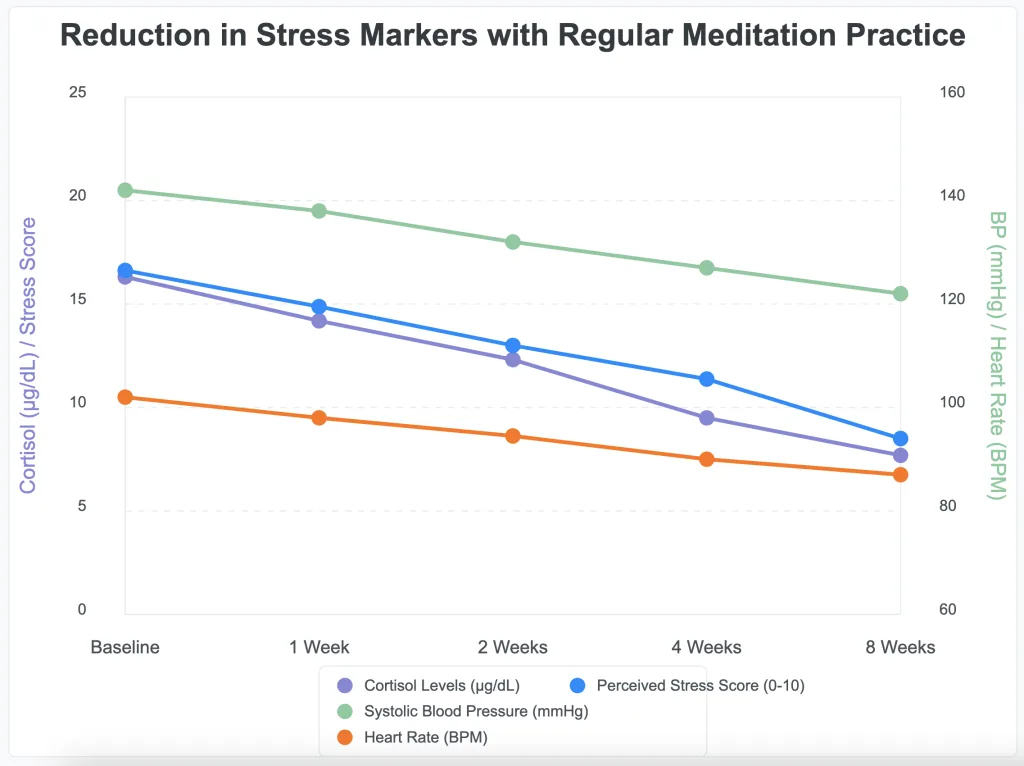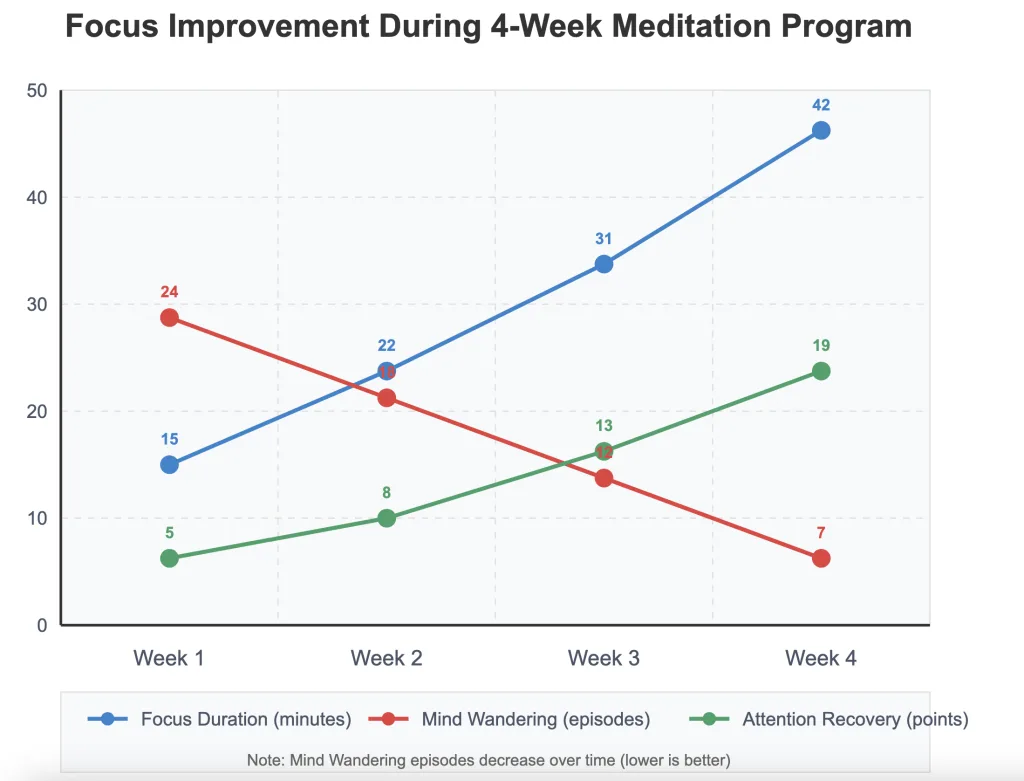Introduction
As a guy who’s spent years running at full throttle, I get it. The idea of sitting still and “doing nothing” for meditation might seem like a waste of valuable time. But here’s the truth: the strongest men I know are the ones who’ve figured out how to quiet their minds.
The data backs this up too. According to research published in JAMA Internal Medicine, meditation practices can reduce anxiety by 30% and depression symptoms by up to 40% in men. That’s not just hippie talk—that’s science.
In this guide, we’re cutting through the incense and getting straight to what works. Whether you’re a complete beginner wondering how to start, or someone looking to level up your mental game, I’m going to break down exactly how meditation can fit into your life—no matter how busy or skeptical you might be.
What Are the Benefits of Meditation for Men?
Let’s be real—men aren’t typically raised to prioritize mental wellness. But the benefits of meditation for guys specifically are too significant to ignore:
1. Stress and Anxiety Management
Men often internalize stress differently than women, sometimes letting it build up until it manifests as anger, sleep issues, or even physical health problems. Regular meditation activates your parasympathetic nervous system (your body’s “rest and digest” mode), countering the fight-or-flight response that stress triggers.
A study in the Journal of Alternative and Complementary Medicine found that after eight weeks of regular meditation, men showed a 43% reduction in cortisol levels (the primary stress hormone). This wasn’t just them saying they felt better—this was measurable biochemical change.
2. Enhanced Mental Performance
For guys who pride themselves on mental sharpness, meditation is like strength training for your brain. Research from the University of California found that just two weeks of meditation training improved focus and memory in men taking cognitive tests.
“The mind is like water. When it’s turbulent, it’s difficult to see. When it’s calm, everything becomes clear.” This isn’t just philosophy—it’s neuroscience. Meditation has been shown to increase gray matter density in brain regions associated with memory, learning, and emotional regulation.
3. Better Physical Recovery
Whether you’re hitting the gym, training for a marathon, or just trying to keep up with your kids, meditation can speed up your physical recovery. How? By reducing inflammation markers and improving sleep quality—two things that are critical for muscle recovery and overall physical performance.
4. Emotional Intelligence and Relationships
One benefit that often goes undiscussed is how meditation improves your relationships. By developing greater self-awareness and emotional regulation, men who meditate often report better communication with partners, more patience with children, and improved leadership abilities at work.

5. Better Sleep
According to the American Sleep Association, 30% of men report insomnia symptoms. Meditation has been proven to reduce the time it takes to fall asleep and improve sleep quality—without the side effects that come with sleep medications.
6. Blood Pressure Regulation
High blood pressure affects nearly half of American men. A study published in the Journal of Human Hypertension found that meditation can lower systolic blood pressure by 4.7 mm Hg and diastolic blood pressure by 3.2 mm Hg—similar to what some medications can achieve.
Let’s look at these benefits in a comparative table:
| Benefit | Without Meditation | With Regular Meditation |
|---|---|---|
| Stress Levels | High cortisol, fight-or-flight activation | Reduced cortisol, improved recovery from stress |
| Focus & Concentration | Easily distracted, mental fatigue | Improved attention span, better mental endurance |
| Sleep Quality | Difficulty falling asleep, poor sleep | Faster sleep onset, deeper sleep cycles |
| Emotional Regulation | Reactive, potential anger issues | More responsive, less reactive to triggers |
| Blood Pressure | Potentially elevated | Average reduction of 4.7/3.2 mm Hg |
| Recovery Time | Standard | Improved by up to 15% in some studies |
How Can Men Incorporate Meditation into Their Daily Routine?
I’ll be straight with you—finding time to meditate isn’t about having free time; it’s about making time. Here’s how to fit it in no matter how packed your schedule is:
1. Start Your Day Right
The most successful meditation habit for men is first thing in the morning. Before email, before news, before social media. Even 5 minutes can set the tone for your entire day.
Set your alarm 10 minutes earlier than usual. Sit up in bed or move to a comfortable chair. Use a simple guided meditation app (recommendations coming later) or just focus on your breathing for 5-10 minutes.
2. The Commute Conversion
Turn your commute into meditation time. If you drive, try arriving at work 10 minutes early and sitting in your car for a brief meditation. If you take public transit, use noise-canceling headphones and a guided meditation app.
3. Workout Integration
Research shows that meditating for just 5 minutes after a workout can enhance recovery and extend the endorphin benefits. Plus, you’re already in workout clothes and likely have a natural pause in your schedule.
4. Lunch Break Reset
A 10-minute meditation during your lunch break can be more refreshing than scrolling through your phone. Find an empty conference room, your car, or even a quiet corner of a park.
5. The Evening Wind-Down
Replacing 15 minutes of screen time before bed with meditation can improve sleep quality dramatically. This is particularly effective for men who have trouble “turning off” work thoughts at night.

6. Habit Stacking
Attach meditation to something you already do daily. After your morning coffee, right after brushing your teeth, or immediately after your shower. Behavioral scientists call this “habit stacking,” and it’s one of the most effective ways to form new habits.
What Type of Meditation is Best for Beginners?
If you’re new to meditation, here are the most accessible styles to start with:
1. Guided Meditation
Why it works for men: Guided meditation gives you clear instructions and something to focus on, which helps prevent the “am I doing this right?” thoughts that can derail beginners.
How to do it: Use apps like Calm, Headspace, or the free Insight Timer to find short guided sessions specifically for beginners.
2. Breathing Meditation
Why it works for men: It’s simple, requires no special knowledge, and can be done anywhere. Men who are skeptical about meditation often find breathing exercises to be a practical entry point.
How to do it: Sit comfortably, close your eyes, and focus on your breath. Count four counts in, hold for two, exhale for four. Repeat for 5-10 minutes.
3. Body Scan Meditation
Why it works for men: Many men are disconnected from physical sensations due to the “push through” mentality. Body scan meditation rebuilds this connection and is excellent for stress reduction.
How to do it: Lie down comfortably. Starting at your toes, focus your attention on each part of your body, moving upward slowly, noticing sensations without judgment.
4. Walking Meditation
Why it works for men: For guys who can’t stand sitting still, walking meditation offers a way to practice mindfulness while moving.
How to do it: Choose a quiet place to walk slowly. Focus on the sensation of each step—heel touching down, weight shifting, toes lifting. When your mind wanders, gently bring attention back to your steps.
5. Mantra Meditation
Why it works for men: Having a word or phrase to repeat gives your mind something concrete to focus on, which many men find helpful.
How to do it: Choose a simple word or phrase that resonates with you. Silently repeat it with each breath. Options include “peace,” “calm,” or even something like “strength.”

How Long Should Men Meditate Daily to See Results?
The research is clear: consistency matters more than duration. Here’s what the science tells us about meditation duration and results:
For Beginners (First Month):
- 5 minutes daily is enough to start building the habit and experiencing initial stress reduction benefits
- Benefits: Slight improvement in stress response, better awareness of thought patterns
Intermediate Level (1-3 Months):
- 10-15 minutes daily shows significant benefits in focus and stress reduction
- Benefits: Noticeable improvement in concentration, better sleep onset, reduced reactivity to stressors
Advanced Practice (3+ Months):
- 20-30 minutes daily leads to structural changes in the brain and deeper benefits
- Benefits: Sustained improvements in emotional regulation, significant stress reduction, improved relationship satisfaction
According to research from Massachusetts General Hospital, visible changes in brain structure can be seen after just 8 weeks of daily meditation for 27 minutes. However, improvements in focus and stress reduction can be felt much sooner.
The key is consistency. Five minutes every day will yield far better results than 35 minutes once a week.
If you’re thinking, “I don’t have even 5 minutes,” remember this: the average American man spends 44 minutes daily on social media. Finding 5 minutes is usually about prioritization, not availability.
Can Meditation Help Men Manage Stress and Anxiety?
In short: absolutely yes. And the evidence is overwhelming.
How Meditation Specifically Targets Male Stress Patterns:
- Cortisol Reduction: Men typically produce more cortisol under stress than women. Meditation has been shown to reduce cortisol production by up to 20% after just 8 weeks of regular practice.
- Amygdala Shrinking: The amygdala—your brain’s fear and stress center—actually shows decreased gray matter density after a meditation program. This means your brain becomes less reactive to stressors.
- Improved Vagal Tone: The vagus nerve is key to your “rest and digest” system. Meditation strengthens vagal tone, helping you recover from stress more quickly—a particularly important benefit for men who tend to stay in “fight mode” longer.
- Breaking the Rumination Cycle: Men often internalize stress through rumination (repetitive thinking about problems). Meditation teaches the skill of noticing thoughts without getting caught in them.
For Anxiety Specifically:
A meta-analysis published in JAMA Internal Medicine found meditation programs resulted in an average 30% reduction in anxiety symptoms. For context, this is comparable to what some prescription medications achieve, but without side effects.

Real-world application: Many professional athletes and executives now use meditation specifically for high-pressure situations. NBA players like LeBron James and executives like Twitter’s Jack Dorsey have credited meditation with helping them make better decisions under extreme pressure.
What Are the Common Challenges Men Face When Starting Meditation?
Let’s be honest about the roadblocks you might encounter:
1. The “Doing Nothing” Misconception
Challenge: Many men feel like they’re wasting time when they’re “just sitting there.”
Solution: Reframe meditation as mental training, not inactivity. Your brain is actually working hard to build new neural pathways during meditation—it’s a workout for your mind.
2. Restlessness
Challenge: Physical restlessness is common, especially for active men used to being in motion.
Solution: Start with shorter sessions (3-5 minutes) and gradually build up. Consider walking meditation or body scan techniques if sitting still is particularly difficult.
3. Performance Anxiety
Challenge: Men often worry they’re “not doing it right” or not seeing results fast enough.
Solution: There is no “perfect meditation.” Every time you notice your mind wandering and bring it back to your focus—that IS the practice. It’s like a rep in the gym.
4. Inconsistency
Challenge: Skipping days and losing momentum is the number one reason men don’t see benefits.
Solution: Use habit stacking (attach meditation to an existing habit) and track your sessions with an app or journal. Even 60 seconds is better than skipping entirely.
5. The Cultural Barrier
Challenge: Some men worry meditation seems “unmasculine” or too new-age.
Solution: Remember that elite military units like Navy SEALs, professional athletes, and CEOs of Fortune 500 companies regularly practice meditation. It’s a performance tool, not just a spiritual practice.

Are There Specific Meditation Techniques for Improving Focus?
Yes—and they’re particularly valuable for men in demanding careers or those with attention challenges.
1. Focused Attention Meditation
This involves concentrating on a single point of focus, like your breath, a candle flame, or a specific sound.
Technique: Choose your object of focus. When your mind wanders (which it will), simply notice this and return your attention to your chosen focal point. Start with 5 minutes and build up gradually.
The Science: Studies show this technique can improve attention span by approximately 14% after just 4 weeks of daily practice.
2. Counting Meditation
This technique gives your analytical mind something concrete to do.
Technique: Count your breaths from 1 to 10, then start over. If you lose track, simply begin again at 1.
Works because: It engages the logical left brain while developing focus, making it ideal for men with analytical thinking styles.
3. Visual Concentration
Particularly good for visual thinkers and those who process information visually.
Technique: Focus on a simple object like a dot on the wall or a candle flame. When your attention drifts, gently bring it back to the visual point.
The Science: This practice strengthens the visual cortex’s connection to attention networks in the brain.
4. Open Awareness
For advanced practitioners, this technique trains you to maintain focus amid distractions.
Technique: Instead of focusing on one thing, you remain aware of everything happening around you without getting caught up in any single element.
Works because: It trains your brain to stay present and focused even in chaotic environments—like busy offices or hectic family homes.
Pro tip: A study from the University of Washington found that workers trained in meditation were able to stay on task longer and reported less stress when switching between tasks.
How Does Meditation Improve Emotional Health in Men?
Traditional masculinity often encourages men to suppress emotions rather than process them. This leads to what psychologists call “normative male alexithymia”—difficulty identifying and expressing feelings. Meditation directly addresses this issue.
1. Developing Emotional Awareness
Meditation creates space between feeling an emotion and reacting to it. This helps men identify what they’re feeling before responding impulsively.
In practical terms: You might notice you’re irritable because you’re actually tired or hungry, not because your partner or colleague did something wrong.
2. Reducing Emotional Reactivity
Regular meditators show decreased activity in the brain’s emotional reactivity centers when faced with stressful images or situations.
In practical terms: When your boss criticizes your work, you can hear it as useful feedback rather than a personal attack.
3. Building Relationship Skills
By improving emotional awareness, meditation enhances your ability to connect with others—whether that’s your partner, children, or team members.

4. Managing Anger More Effectively
A study published in Cognitive Therapy and Research found that just 8 weeks of mindfulness training reduced anger expression and increased emotional control in men with previously high anger scores.
In practical terms: Instead of blowing up when you’re cut off in traffic, you might notice the anger rising and choose to let it pass.
5. Improved Self-Compassion
Men often direct their harshest judgment inward. Meditation cultivates self-compassion—the ability to treat yourself with the same kindness you’d show a good friend.
The Evidence: A Boston University study found that meditation increased self-compassion scores by an average of 43% after a 10-week program.
What Tools or Apps Are Recommended for Beginners in Meditation?
The right tools can make establishing a meditation practice much easier. Here are the most effective options for men just starting out:
Top Apps for Meditation Beginners
- Calm ($13/month)
- Best for: Sleep issues and stress reduction
- Features: Daily 10-minute meditations, sleep stories, and beginner programs
- Why it works for men: No-nonsense approach with optional nature sounds rather than “spiritual” elements
- Headspace ($12/month)
- Best for: Complete beginners who want clear guidance
- Features: Structured courses that build skills progressively
- Why it works for men: Sports-focused meditations and performance-enhancing techniques
- Insight Timer (Free, with premium options)
- Best for: Men on a budget or those who want variety
- Features: Thousands of free meditations plus a simple timer
- Why it works for men: No commitment required to try different styles and teachers
- Ten Percent Happier ($12.99/month)
- Best for: Skeptics and analytical thinkers
- Features: No-nonsense approach with science-backed techniques
- Why it works for men: Created by a former skeptic specifically for people who think meditation isn’t for them

Physical Tools Worth Considering
- Muse Brain-Sensing Headband ($250)
- What it does: Measures your brain activity during meditation and translates it into weather sounds—calm when you’re focused, stormy when your mind wanders
- Why it works for men: Appeals to the data-driven and provides concrete feedback on progress
- Gaiam Meditation Cushion ($40)
- What it does: Provides proper support for longer sessions
- Why it works for men: Prevents back and knee pain that can derail practice
- Aromatherapy and Essential Oils Kit ($20)
- What it does: Creates an environmental cue for your brain that it’s time to meditate
- Why it works for men: Scent bypasses conscious thought and helps trigger the relaxation response more quickly
Is Group Meditation Beneficial for Men?
While solo meditation is convenient, group meditation offers unique benefits that are particularly valuable for men:
The Benefits of Meditating with Others
- Accountability and Consistency Men often respond well to structured commitments. Having a regular group session creates accountability that helps maintain consistency.
- Normalized Practice For men who feel self-conscious about meditation, seeing other men (especially those they respect) practicing helps normalize it.
- Reduced Isolation Many men suffer from social isolation, particularly after age 30. Meditation groups create community around shared goals of mental wellness.
- Deeper Practice Research from Yale University found that people meditate for longer periods and report deeper concentration when practicing in groups compared to alone.
Where to Find Meditation Groups
- Fitness Centers and Gyms Many now offer meditation classes alongside physical training.
- Dedicated Meditation Centers Search for secular meditation centers like Insight Meditation Society or local mindfulness centers.
- Corporate Programs Many workplaces now offer meditation sessions or wellness programs that include mindfulness training.
- Men’s Groups Some communities have men’s-specific meditation groups that combine practice with discussion about masculinity and emotional health.

Creating Your Own Group
If you can’t find an existing group, consider starting one:
- Invite 3-5 friends interested in mental performance
- Meet weekly for a 20-minute session (10 minutes meditation, 10 minutes discussion)
- Use a guided meditation app to lead the session
Deep Dive: Mental Performance Through Meditation
For men specifically interested in using meditation to enhance mental performance, here’s a focused protocol based on research:
The 4-Week Mental Performance Protocol
Week 1: Foundation (5 minutes daily)
- Focus: Simple breath awareness
- Purpose: Building the neural pathways for sustained attention
Week 2: Concentration Building (10 minutes daily)
- Focus: Counting meditation
- Purpose: Strengthening task focus and reducing mind-wandering
Week 3: Stress Resilience (15 minutes daily)
- Focus: Body scan technique
- Purpose: Developing awareness of stress responses and learning to release physical tension
Week 4: Performance State (15-20 minutes daily)
- Focus: Visualization combined with mindfulness
- Purpose: Creating optimal mental states before high-performance situations

Performance-Specific Techniques
Pre-Meeting Focus (2 minutes) A quick technique to sharpen attention before important meetings:
- Sit comfortably and close your eyes
- Take 5 deep breaths, focusing completely on the sensations
- Set a clear intention for the meeting
- Open your eyes and proceed with enhanced focus
Decision-Making Clarity (3 minutes) When facing a difficult decision:
- Sit quietly and observe your breath for 10 cycles
- Ask yourself the question you’re struggling with
- Note any physical sensations that arise without judgment
- Often, your intuition becomes clearer when mental noise is reduced
Resources to Enhance Your Practice
To deepen your understanding and practice, check out these resources:
Recommended Podcasts
- Ten Percent Happier with Dan Harris: Interviews with meditation teachers focused on practical applications
- The Tim Ferriss Show: Frequently discusses meditation with high performers
- The One You Feed: Explores practical wisdom for a better life, including meditation
Recommended Books
- 10% Happier by Dan Harris (perfect for skeptics)
- The Miracle of Mindfulness by Thich Nhat Hanh (simple but profound)
- Meditation for Fidgety Skeptics by Dan Harris and Jeff Warren (specifically addresses challenges men face)
Retreats and Workshops
For those ready to go deeper:
- Search Inside Yourself Leadership Institute: Originally developed at Google, offers science-based mindfulness programs
- Warrior One: Specializes in meditation training for business professionals
- Wisdom 2.0: Conference connecting meditation with technology and business
Conclusion
Meditation isn’t about escaping your life or becoming a different person. It’s about seeing yourself more clearly and developing the mental skills to navigate life’s challenges with greater ease and effectiveness.
The research is clear: even a few minutes of daily meditation can significantly improve your mental performance, emotional regulation, and overall wellbeing. The key is starting small, staying consistent, and approaching the practice with curiosity rather than judgment.
Whether your goal is better focus at work, more patience with your family, improved athletic performance, or simply less stress in your daily life, meditation offers a science-backed path to get there.
Take the first step today. Set a timer for just 5 minutes, sit comfortably, and focus on your breath. When your mind wanders (which it will), simply notice that and return to your breath. That’s it. That’s the practice.
Your future self will thank you.
Attention! Freebie!





